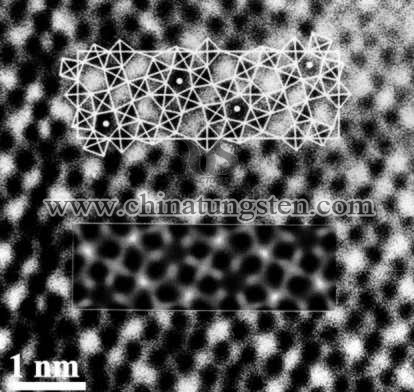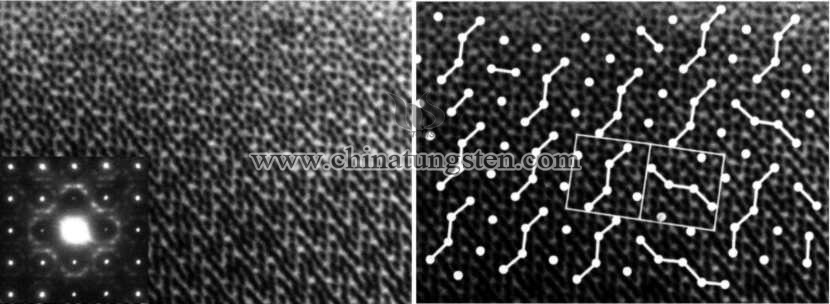Bronze-type Niobium Tungsten Oxide
- Details
- Category: Tungsten Information
- Published on Thursday, 02 August 2018 19:09
In the pseudo-binary system Nb2O5/WO3, Nb8W9O47, crystallizing in a threefold superstructure of the tetragonal tungsten bronze (TTB) type, represents the most stable compound. The superstructure arises from a systematic occupation of a part of the pentagonal channels with metal-oxygen strings (see figure).

Bronze-type niobium tungsten oxide (Nb8W9O47) can be regarded as the end member of a solid solution series Nb8-nW9+nO47 (n=0-5) in which Nb5+ is formally substituted by Nb4+ (or W4+) and W6+. The amount of reduced cations in these phases can be oxidized, and that provides a novel access to the fully oxidized system Nb2O5/WO3. The oxidation on air leads to different products depending on the oxidation temperature. Of particular interest is the oxidation at low temperatures T<1000°C that results in novel metastable structures, among them a TTB superstructure observed here for the first time. Furthermore, different variants of diffuse scattering that appear in the electron diffraction patterns are associated with a little ordered occupation of the pentagonal tunnels. For the characterisation of the oxidation products, high-resolution transmission electron microscopy (HRTEM) is an indispensable tool: in projection along the short axis, the structure can be determined directly since the positions of the cations can be recognized as dark dots. Different structural variants are produced by the in-situ oxidation in the gas reaction cell of a modified transmission electron microscope (cooperation with John L. Hutchison, Department of Materials, University of Oxford, and Maria J. Sayagués, Instituto de Ciencia de Materiales de Sevilla CSIC).

HRTEM image of a microdomain of Nb6W8O39, a novel TTB superstructure found in the oxidation product of Nb7W10O47. The interpretation (right side) shows the distribution of filled pentagonal tunnels (white dots). Two different orientations of the unit cell (marked as frames) occur. Besides this twinning, disorder of the tunnel occupation causes diffuse scattering in the electron diffraction pattern (inset on the left side).
- Tungsten Manufacturer & Supplier, Chinatungsten Online: www.chinatungsten.com
- Tungsten News & Prices of China Tungsten Industry Association: www.ctia.com.cn
- Molybdenum News & Price: news.molybdenum.com.cn
- Tel.: 86 592 5129696; Fax: 86 592 5129797; Email: sales@chinatungsten.com



 sales@chinatungsten.com
sales@chinatungsten.com